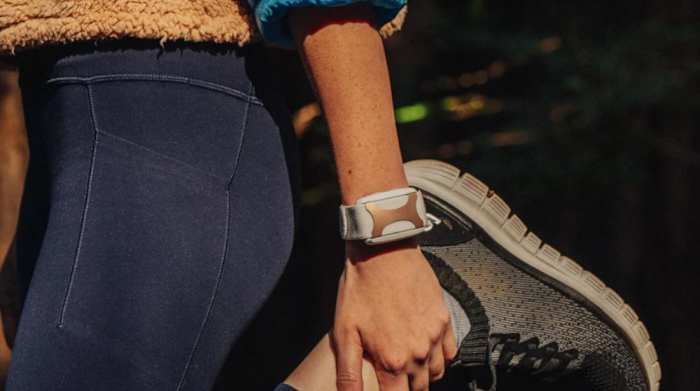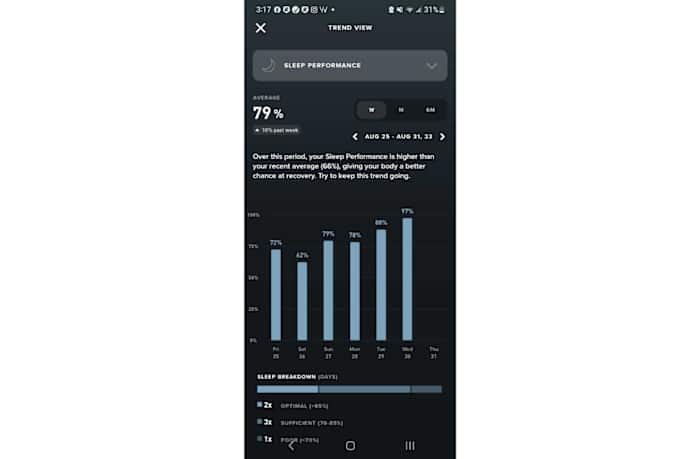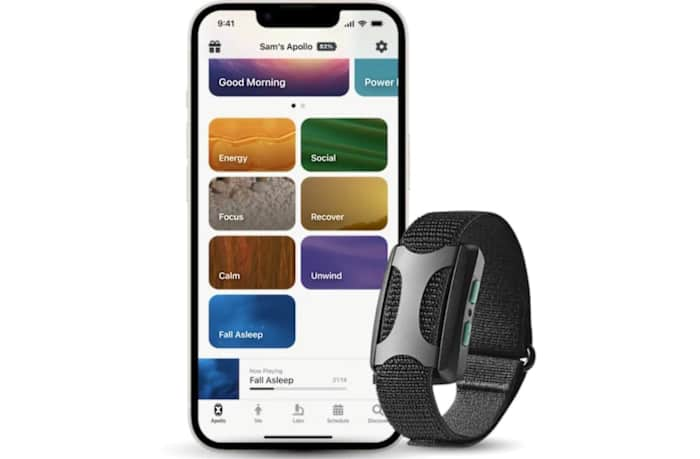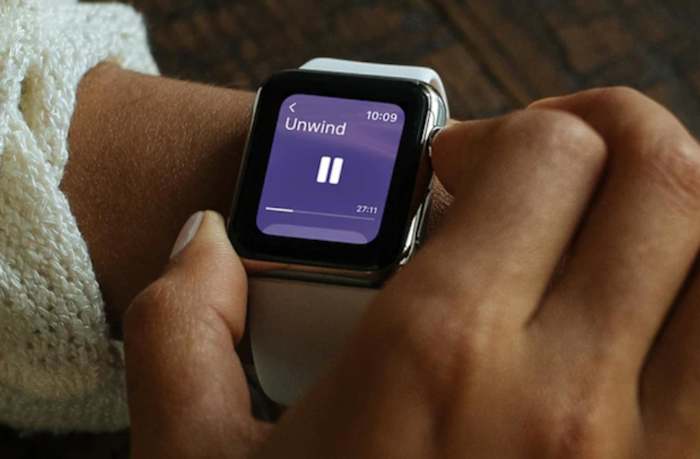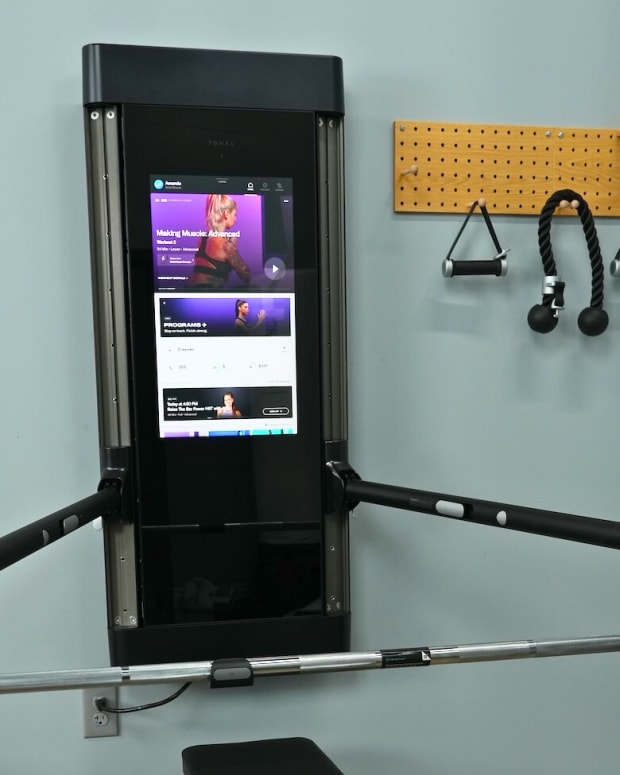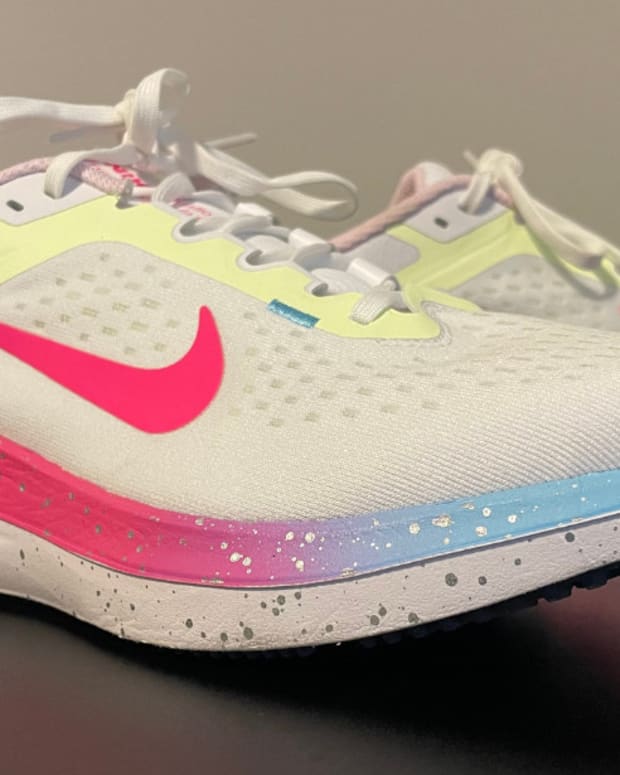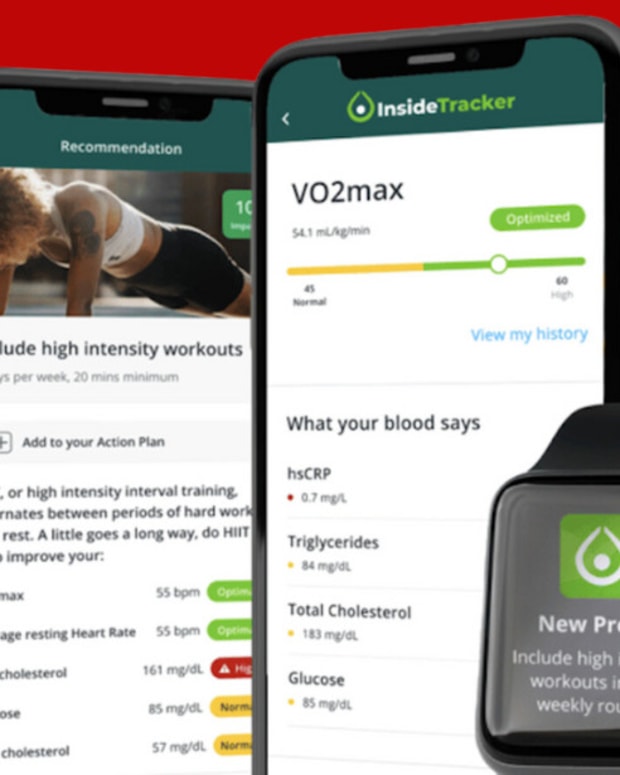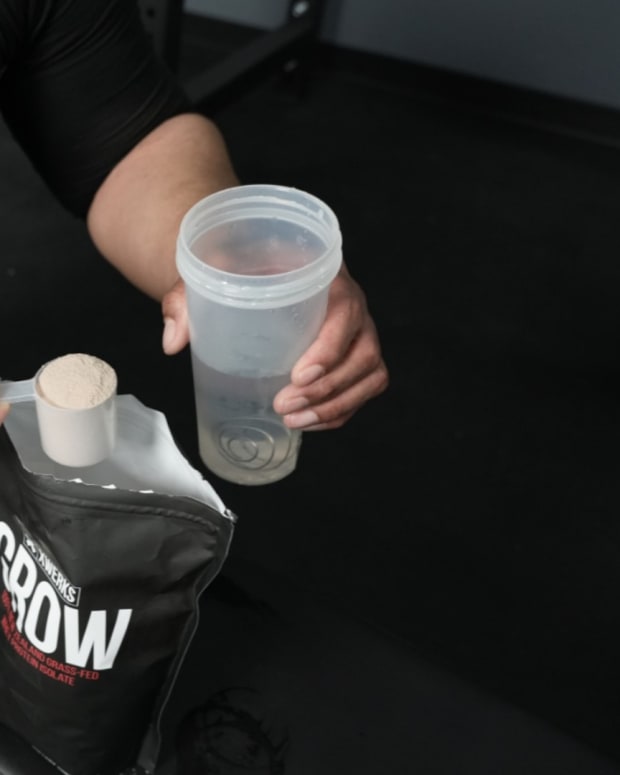The products featured in this article have been independently reviewed. When you buy something through the retail links on this page, we may earn commission at no cost to you, the reader. Sports Illustrated editorial staff are not involved in the creation of this content. Learn more here.
Health and fitness wearables have revolutionized the way we approach personal wellness. These innovative devices, ranging from smartwatches to fitness trackers, offer users numerous benefits beyond simply tracking steps and heart rate. As the devices continue to evolve and integrate with our daily lives, their potential to improve our overall well-being is endless.
One of the newest and most innovative wearable devices to hit the market is the Apollo wearable from Apollo Neuro. Similar in size to a Samsung or Apple Watch, the Apollo Neuro is designed to transform the way you feel through your sense of touch. Developed by physicians and psychiatrists, it delivers soothing vibrations via sound waves to help provide users with more energy, less stress, an improved mood and better sleep.
Here, we’ll discuss everything you need to know about this product. From how it works and the science behind the claims, to the pros and cons and the cost to as well as my tested feedback, we’ll help you make an informed decision about whether the Apollo wearable is right for you.
This content is meant to be informative, but should not be taken as medical advice. It is not intended for use as diagnosis, prevention or treatment of health problems. Always speak with your doctor before starting any new supplement or exercise regimen.
The Apollo Wearable at a Glance
- Wearable tech that’s designed to improve energy, stress relief, sleep, and focus
- Emits low-frequency sound waves felt as tiny vibrations to change how you feel
- Ability to schedule your daily “Apollo Vibes” to automatically play at set times throughout the day
- Designed to be worn for three hours a day, five days a week for the best results
- Connects to other health tracking wearables, including Oura Ring, Apple Watch, and Apple Health
Related Post: The Best Sleep Tracking Apps
Pros:
- The Apollo wearable transforms how you feel naturally, through your sense of touch rather than a drug or medication such as caffeine, nicotine or melatonin
- The Apollo Neuro app offers eight different “Apollo Vibes” to choose from, including Energy, Social, Focus, Power Nap, Recover, Calm, Unwind and Fall Asleep
- The Apollo wearable has no negative side effects
- Backed by science, including two double-blind randomized placebo-controlled crossover studies, seven completed clinical trials, and 14 more currently underway
- Backed by a 1-year warranty
Things to consider:
- The current iteration of the Apollo wearable is slightly clunky, about twice the size of the Whoop health and fitness tracker
- The Apollo wearable doesn’t actually track anything aside from your usage, and instead requires you to set which of the eight “Apollo Vibes” you want to use to improve how you feel
Apollo Neuro Claims
The Apollo Neuro wearable device is designed to change the way you feel by releasing low-frequency sound waves that you can sense through your skin. These tiny vibrations, the “Apollo Vibes,” range in length and intensity to promote anything from energy and focus to a sense of calm and recovery. Higher vibrations help improve energy and focus, while lower vibrations reduce stress and help you relax. Each of these eight Apollo Vibes is designed to put you in control of how you feel.
Related Post: The Best Ashwagandha Supplements for Relieving Stress
The mission of the Apollo Neuro team is to help people take control over their stress and live healthier and happier lives. In order to prove their device’s efficacy, the company is engaged in promising scientific research, including seven completed and 14 ongoing clinical trials. Here are some of the main benefits the Apollo Neuro website highlights from their completed clinical studies.
- 40 percent less stress and feelings of anxiety, on average
- Up to 25 percent more focus and concentration
- 11 percent average increase in HRV (heart-rate variability), on average
- Up to 19 percent more time in deep sleep
- 10 percent faster physical recovery, on average
- Up to a 4 percent lower heart rate
With 14 more clinical trials underway, focused on the specific relationship between the Apollo wearable and stress-related conditions, it will be exciting to hear the results of this testing.
How Does the Apollo Wearable Work?
Here is a basic rundown of how the Apollo wearable works.
- Put your Apollo wearable on your wrist or ankle via a band, or attach it to your shirt collar, bra strap or waistband using a clip. (Both the band and clip are included with your purchase)
- Turn on your desired Apollo Vibe (Energy, Social, Focus, Power Nap, Recover, Calm, Unwind, Fall Asleep) via the app and experience the low-frequency sound waves felt as gentle vibrations
- Adjust the intensity to suit your needs. Apollo recommends starting at a low intensity, around 20 to 40 percent, and only increasing as you need. They compare it to playing music through your headphones, in which you wouldn’t want to experience the full volume right away.
Apollo device
The Apollo touch therapy device is a wearable that actually produces the low-frequency sound waves you will feel as gentle vibrations. The device is slightly larger than a standard Apple or Samsung watch and feels slightly clunky at first. During the first few uses I did get used to the feel, however, if you would prefer not to have it around your wrist, you do have the option to place it on your ankle or attach it to other places on your body via the clip.
What’s great about the device is that you don’t always need your phone nearby to play Apollo Vibes. You have the ability to replay the last Apollo Vibe you used by simply pressing both buttons on the side of the device simultaneously. This is a great feature for when you wake up in the middle of the night and want to use the Apollo wearable to fall back asleep.
You’re also able to adjust the intensity without your phone as each button press changes the intensity by 5 percent. The button with a raised dot allows you to increase the intensity, while the smooth button allows you to decrease it.
The Apollo Neuro app
The Apollo Neuro app, simply named Apollo, is available for download on both Android and iOS devices via the Google Play and Apple App store. The app has an intuitive design that's simple, colorful and easy to use.
Once downloaded onto your phone, you can access several features, including the eight different Apollo Vibes mentioned previously, track your Apollo Neuro usage and schedule your daily vibes playlist. The schedule is a nice feature if you maintain a fairly consistent routine and want to play specific vibes at set times throughout the day.
Related Article: The 8 Best Health Apps
Apollo stress relief
The Apollo wearable is designed to help you relieve stress. Apollo states that these sound waves, in particular, will help you rapidly relieve stress for deep relaxation, whether it's for before bed or after periods of intense stress. This can be seen in the two double-blind placebo-controlled clinical trials where HRV was clinically proven to improve. (HRV is a metric that shows general well-being and ability to bounce back from stressful situations.)
While I don't consider myself to be a particularly stressed-out person, I did use the Unwind vibe before bed and found that I did feel more relaxed. I know this is purely anecdotal, but many customer reviews on the Apollo Neuro website echo this sentiment.
The Apollo Wearable Cost
The full price of the device is $349.99, however the time of publication, the Apollo Neuro is on sale for $299.99. This price includes the device, arm or ankle band, clip holder, micro-USB charging cord and free access to the Apollo Neuro app. While this is a hefty upfront cost, I actually do prefer the one-time payment compared to the subscription-based model other companies, such as Whoop, use.
If you think that the Apollo wearable will help you and you can commit to using it consistently, then I believe the price point of less than a dollar a day for a year is justified. The benefits are compounding, as the Apollo wearable is designed to help reset your nervous system over time.
Unfortunately, the only way to really test out this product is to try it for yourself. This is why Apollo is offering a 30-day risk-free money-back guarantee on all Apollo devices. They also have certified refurbished Apollo wearables for as low as $199.99 that come with a 90-day limited warranty.
Who Should Use the Apollo Wearable
While I do believe that the Apollo wearable could potentially help anyone, I don't believe this product is meant for everyone. As Apollo states, the best results are seen when users can commit to using the device for three plus hours a day at least five days a week. This means that consistency is a must for long-term success and results. With the scheduling feature, this is pretty easy, as you can just set it and forget it. There’s even a quiz called “Your Daily Vibes” that builds a custom schedule based on your unique schedule and energy levels throughout the day.
As I was testing out the device I brainstormed a number of applications in which I could truly see the Apollo Neuro having some serious benefits.
Travel
Individuals who travel a lot, whether it's for work or pleasure, would definitely find uses for the Apollo wearable. This is especially true for people who travel across different time zones, or take long distance flights, and need an easy and familiar process to help them fall asleep, or possibly stay awake for business. I also considered individuals who drive long distances, such as long-haul truck drivers. Apollo's energy vibe would be a great way to help these drivers stay alert and safe throughout their trips.
Performance
The Apollo wearable may help improve performance, whether you’re taking part in an intense workout or leading a presentation at work, Apollo’s Focus vibe can help you stay clear headed and centered on the task at hand. Individuals that often experience the classic afternoon slump may also benefit from Apollo wearable by using the device to quickly fall asleep for a quick power nap, or as a way to power through the day with the energy vibe.
Stress and anxiety
Individuals who work highly stressful jobs, such as cops, firefighters, nurses, high-powered executives, etc., are highly stimulated throughout the day and may need a way to decompress and unwind after a long workday or shift. Apollo may have the ability to help place you into a calm headspace to relax from your day. Many users have also found success using Apollo in social situations, with one user writing, "Apollo helps me socially; I am getting more comfortable going out again and enjoying social situations, just feeling more 'normal' when I go out." If you suffer from social anxiety, then the Apollo wearable may just be the emotional support tool you can rely on to conquer any social gathering.
Who Should Not Use the Apollo Wearable
If you've tried using wearable devices in the past and haven't been able to stay consistent, then this may not be the product for you. In many cases, other wearables such as the Whoop, Garmin, Oura-Ring, and Apple Watch will track your health and fitness data as long as you are wearing the device. The only responsibility you have is to simply keep the device charged and wear it.
However, the Apollo wearable doesn't actively track your biometrics and instead relies on you to use the device by playing the Apollo Vibe of your choice via the app. If you aren’t sure whether you want to commit to routinely using this product, then I don’t think it’s worth the purchase.
About Apollo Neuro
Apollo Neuro was born from years of neuroscience research conducted by David Rabin, MD, at the University of Pittsburgh Medical Center. Rabin was interested in understanding how different vibrational frequencies affect the body. The data suggested that it was possible to use the body’s natural response to different forms of touch to help calm the nervous system and alleviate symptoms of chronic stress. The outcome was a wearable device that could safely and effectively deliver soothing vibrations to the body’s touch receptors of the skin. Thus the Apollo wearable was born, with the goal of helping individuals cope and adapt with their modern lives.
What makes this product stand out from the competition is that it’s not a biometric health and fitness tracker and instead is a therapeutic wearable designed to promote stress resilience, sleep, focus, recovery, and more. This concept truly places the Apollo wearable in a league of its own as it paves the way for an entirely new genre of wearable devices that will directly interact with how we live.
Apollo vs. Whoop
The Apollo Neuro and Whoop are honestly completely different devices—but they can be complimentary. The goal of the Apollo Neuro is to change the way you feel through your sense of touch, while the Whoop is designed to measure your daily sleep, recovery and activity strain. In reality, the best way to compare these two devices is to show how well they complement one another.
The Apollo wearable is designed to help improve your sleep performance, heart rate variability, recovery and reduce your stress levels—however it doesn’t actually track these metrics. The Whoop, on the other hand, tracks all of this biometric data and provides insights into improving your health and wellness, but doesn’t actively promote any changes. Therefore, these devices are actually a perfect combination to see if the use of the Apollo wearable is providing any real benefit.
Fortunately, I also have a Whoop and was able to track my sleep performance over the course of a week while using the Apollo Neuro. The first night I used the Apollo Neuro was Monday the 28th and continued through two more nights until Wednesday the 30th. As you can see from this data, my sleep performance did improve over the course of the three nights. That being said, I’m not saying the sole reason for the improved performance was the use of the Apollo wearable, however, in 6-months of using the Whoop a 97 percent sleep score was the highest I have ever achieved.
Apollo vs. Apple Watch
The Apple Watch is a versatile wearable device that offers a wide range of features and functions similar to a cell phone. The Apple Watch does perform some health and fitness tracking, such as steps taken, distance traveled and calories burned. It can also monitor your heart rate, provide alerts for irregular heartbeats and some models even have fall detection that can automatically call for help if it detects a hard fall followed by inactivity. That being said, the Apple Watch is best known for allowing you to make calls, send texts and emails, play music and podcasts and even allow you to pay for things.
Apollo can do none of these things, not even tell the time, but that’s not its purpose. The Apollo wearable is designed to change the way you feel through sound-wave vibrations rather than track health and fitness data or make phone calls. Similar to the Whoop, using both the Apple Watch and Apollo wearable is a great way to take advantage of their synergistic effects, with one allowing you to make changes to the way you feel, while the other tracks the results. Plus, the Apollo wearable has an integration with Apple Health, so the two can work together to support you in your mental and physical health. And, your Apollo minutes will count as your Mindful Minutes in Apple Health so you get that credit for taking good care of yourself. Apollo also has an app for your Apple Watch so you can change Vibes without your phone nearby.
Apollo Neuro FAQs
Can you use the Apollo wearable too much?
While there are no risks to using Apollo a lot, I would suggest following their recommended guidelines and building up from there if desired. Apollo states that the goal use time should total at least three hours a day, five days a week for the best results.
Is the Apollo wearable safe?
Yes, the Apollo wearable device is completely safe. The Apollo website states that numerous forms of vibration have demonstrated no significant negative reactions from routine use. Apollo also states that vibrations caused by the device are at decibel levels that have not been found to pose any risk of harm.
How long does the Apollo wearable charge last?
At full charge, the Apollo wearable battery is designed to provide six to eight hours of continuous use.
Should you wear the Apollo device on the wrist or ankle?
Apollo suggests that you wear the Apollo device in whichever location on the body you prefer. You have the option to place it around the wrist or ankle using the band or on various other spots around the body using the clip. Based on consumer reviews on the Apollo website, it seems that many people prefer to have it around the wrist during the day, but prefer to place it around the ankle during sleep.
Does the Apollo werable help with anxiety?
The soothing vibrations of the Apollo wearable are designed to help reduce feeling of anxiety by calming and rebalancing the nervous system. Over time, the wearable helps to retrain the nervous system to adapt to stress more effectively and reduce anxiety altogether.
Takeaway: Is Apollo Neuro Worth It?
Health and fitness wearables are no longer just fashion accessories, they are powerful tools that empower individuals to take control of their health and make informed decisions about their physical and mental well-being. In my opinion, the Apollo wearable is the next step in the evolution of wearable devices from complex biometric trackers to instruments that deliver real therapeutic outcomes.
After testing the product, I do think that the Apollo wearable is a worthwhile device for many different individuals and a number of different applications. Apollo Neuro is also constantly innovating, with its newest feature being new Vibes and more personalization, like Stay Asleep. When enabled, Stay Asleep will allow your Apollo to respond automatically and play soothing Vibes to help keep you asleep throughout the night. If you’re at all interested in what the Apollo wearable has to offer, I encourage you to at least take advantage of their 30-day, no hassle money-back guarantee to see if this product is the right fit for your needs.
Prices are accurate and items in stock as of publish time.
